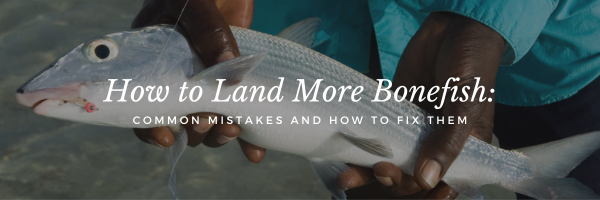How to Land More Bonefish: Common Mistakes and How to Fix Them
If you’ve ever hooked a bonefish only to watch it vanish in a blur, you’re not alone. Bonefish are notorious for being one of the most challenging species to catch—not just because of their speed, but because they seem to have a sixth sense for detecting anything unnatural. Whether you’re new to the flats or have been chasing bonefish for years, refining your technique can mean the difference between a missed opportunity and a fish in hand. Let’s break down some of the most common mistakes anglers make and how to fix them.
Spooking the Fish Before You Even Get a Shot
One of the biggest challenges with bonefish is simply getting close enough for a good cast. These fish are hyper-aware of their surroundings and will bolt at the slightest disturbance. Many anglers don’t realize how much noise they’re making—wading too aggressively, shifting their feet in the boat, or even casting with too much force. The key here is stealth. Whether you’re wading or fishing from a skiff, slow and controlled movements are essential. Keep your steps light, your profile low, and your casts smooth. And if you see a school of fish? Take your time. Rushing a cast will almost always do more harm than good.
Poor Casting Accuracy
Bonefish aren’t the type to chase down a fly from yards away. If your cast isn’t in the right spot, the fish will likely ignore it. One of the most frustrating things to witness is a perfect opportunity—fish cruising right in front of you—only to have your fly land too far away or, worse, right on top of them.
The best approach is to lead the fish. If they’re moving, you want your fly to land a few feet in front of them, not behind them or directly at them. That way, when you start your retrieve, it looks like a natural shrimp scurrying along the bottom. Practicing your casting before your trip—especially in windy conditions—can make a huge difference. Flats fishing requires speed and accuracy, and if you hesitate or false cast too many times, that opportunity will be gone before you know it.
Using the Wrong Fly
You wouldn’t throw a giant baitfish pattern to a trout sipping mayflies, right? Bonefish aren’t quite that picky, but using the wrong fly can still cost you. The trick is to match the conditions. Lighter flies with bead-chain eyes work well in shallow water, while heavier flies help get down to fish in deeper flats. A Gotcha or Peterson’s Spawning Shrimp is a great place to start, but always pay attention to how the fish are reacting. If they follow your fly but don’t eat, it might be time for a change.
Stripping Too Aggressively
A lot of anglers get excited when they see a bonefish approaching and start stripping the fly too quickly. The problem is, that’s not how a shrimp moves. A bonefish doesn’t need a high-speed chase—it just needs a little movement to trigger its predatory instincts. A slow, steady strip with short, subtle pauses is usually all it takes. Sometimes, the best move is no move at all. If a fish is following your fly closely, let it sit for a moment. More often than not, that pause is what convinces the fish it’s time to eat.
Lifting the Rod Instead of Strip Setting
This is one of the most common mistakes anglers make when transitioning from freshwater to saltwater fishing. In trout fishing, lifting the rod when a fish eats is instinctual. But if you do that with a bonefish, you’ll likely just pull the fly right out of its mouth. The correct method is a strip set—when you feel the fish take the fly, keep your rod tip down and make a firm, long pull on the line. This drives the hook into the fish’s tough mouth and ensures a solid hookup.
Fighting Bonefish Too Hard (Or Not Hard Enough)
Once a bonefish is hooked, it’s going to run—fast. Some anglers panic and clamp down on the reel too soon, snapping their leader. Others do the opposite and give the fish too much slack, letting it throw the hook. The key is balance. Let the fish run, but keep steady pressure on the line. Make sure your drag is set correctly before you even make a cast, so you’re not fumbling when it matters most.
Bonefish are built to challenge even the most skilled anglers, but that’s what makes them such a rewarding species to pursue. Every missed fish is a lesson, and every landed fish feels like a true achievement. If you focus on moving quietly, casting accurately, choosing the right fly, and mastering the strip set, your odds of success will skyrocket.
And if you’re fishing at East End Lodge, don’t hesitate to ask your guide for help. They’ve spent years learning the nuances of these waters and can offer real-time advice that makes all the difference.
So next time you step onto the flats, slow down, stay focused, and embrace the challenge. The bonefish aren’t making it easy for you—but that’s exactly why you’re here.








